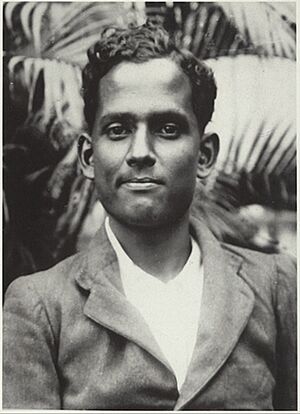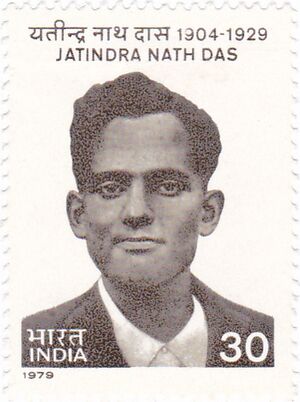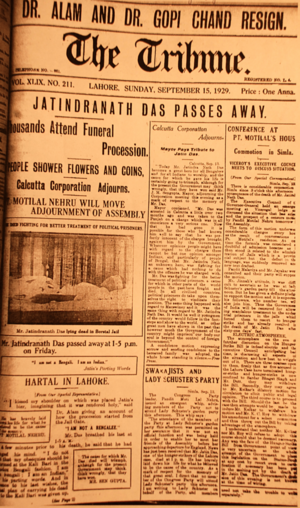Jatindra Nath Das facts for kids
Quick facts for kids
Jatindra Nath Das
|
|
|---|---|
| যতীন্দ্রনাথ দাস | |

Jatin Das around 1929
|
|
| Born |
Jatindra Nath Das
27 October 1904 |
| Died | 13 September 1929 (aged 24) |
| Cause of death | Hunger strike |
| Nationality | Indian |
| Other names | Khedu,Jatin Da |
| Occupation | Revolutionary |
| Employer | Hindustan Socialist Republican Association |
| Known for |
|
| Signature | |
Jatindra Nath Das (Bengali: যতীন্দ্রনাথ দাস; born October 27, 1904 – died September 13, 1929), often called Jatin Das, was an Indian freedom fighter. He was a revolutionary who worked hard to make India free from British rule. He was part of the Hindustan Socialist Republican Association. Jatin Das sadly passed away in Lahore Central Jail after going on a hunger strike for 63 days.
Contents
Early Life and Fight for Freedom
Jatin Das was born in 1904 in a city called Calcutta. He was a very good student and passed his early exams with high marks. When he was just 17, he joined a group of revolutionaries in Bengal called the Anushilan Samiti. These groups wanted to achieve India's independence.
He also took part in Mahatma Gandhi's non-cooperation movement in 1921. This movement was a peaceful way to protest British rule.
In November 1925, while studying at Bangabasi College, Jatin Das was arrested for his political actions. He was sent to jail in Mymensingh. While there, he started a hunger strike to protest how badly political prisoners were treated. After fasting for twenty days, the jail's leader said sorry, and Jatin Das stopped his fast.
On June 14, 1929, he was arrested again for his revolutionary activities. He was sent to Lahore Jail for a legal case known as the Lahore Conspiracy Case.
Why He Went on Hunger Strike
In Lahore Jail, Jatin Das and other freedom fighters began another hunger strike. They demanded that Indian political prisoners be treated the same as European prisoners. The conditions for Indian prisoners were very bad. Their uniforms were not washed often, and the kitchen areas had rats and cockroaches, making the food unsafe. Indian prisoners also did not get newspapers or paper to write on. However, British prisoners in the same jail had much better conditions.
Jatin Das started his hunger strike on July 13, 1929. It lasted for 63 days. The jail tried to force-feed him and the other activists. Eventually, the jail suggested letting him go, but the government said no. They only offered to release him on bail.
His Death and Legacy
Jatin Das died on September 13, 1929. A brave woman named Durgawati Devi led his funeral procession. The procession traveled by train from Lahore to Calcutta. Thousands of people came to the train stations to honor Jatin Das. In Calcutta, a two-mile-long procession carried his coffin to the place where he was cremated. Subhash Chandra Bose himself met the coffin at the Howrah railway station and led the procession. Jatin Das's hunger strike in prison was a very important moment in the fight against unfair arrests.
After his death, many leaders across India paid tribute to him. Motilal Nehru suggested stopping a meeting of the Central Assembly to protest the harsh treatment of prisoners in Lahore. This protest motion was approved. Jawaharlal Nehru said that Jatin Das had joined the "long and splendid roll of Indian martyrs." He asked people to find strength to continue the fight for freedom.
Subhash Chandra Bose called Jatin Das the "young Dadhichi of India." This referred to a famous story about a wise man named Dadhichi who gave up his life to help others.
See Also
- Batukeshwar Dutt
- Pritilata Waddedar
- Potti Sreeramulu
- Thileepan
- Bhagat Singh
- Chandra Shekhar Azad
- Bagha Jatin



